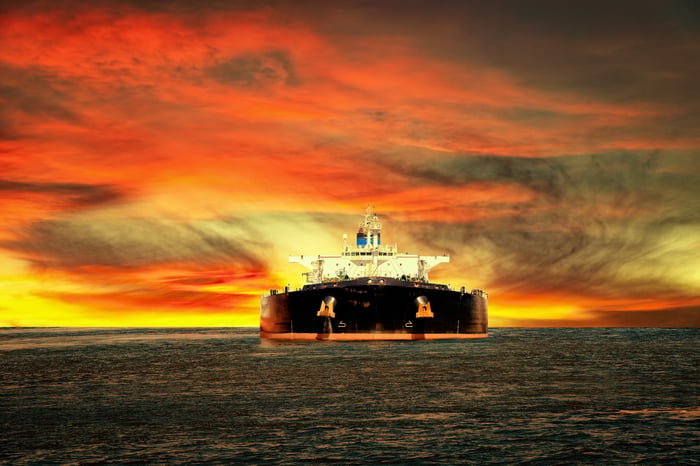America is awash in oil. According to the U.S. Energy Information Administration (EIA), the country is on pace to produce an average of 10.7 million barrels per day (BPD) this year, which is a huge jump from last year's average of 9.4 million BPD. Meanwhile, the EIA sees oil output in the country rising to an average of 11.5 million BPD next year, with additional growth likely in the future.
There's just one problem with this gusher of new output: America doesn't have the infrastructure necessary to transport and process this oil. Because of that, crude that sells at the U.S. benchmark price, WTI, currently fetches roughly $10 a barrel less than oil priced at Brent, which is the global oil benchmark. Multiply that by the country's current production rate, and U.S. producers are missing out on more than $100 million in revenue per day. While the industry is working to solve this problem and narrow the discount, it could be years before U.S. producers will be able to capture the full value of the country's oil.

Image source: Getty Images.
From one bottleneck to another
As bad as the price spread between WTI and Brent might be, an even deeper discount exists between WTI and oil sold in the Permian Basin, which has been as much as $20 a barrel. Driving that wide gap has been the fact that pipelines transporting crude out of the region are quickly filling up. Currently, the Permian has enough capacity to move 3.6 million BPD. Output, however, has been growing at a fast pace and is expected to average around 3.5 million BPD by next month.
The region's capacity constraints will likely hold back the Permian's growth engine until the end of next year, when new pipelines enter service. One of those projects is the Grey Oak Pipeline system, which is an 800,000-BPD pipeline under development by Phillips 66 Partners (PSXP) and Andeavor (ANDX). The companies currently expect the $2 billion oil pipeline to start up by the end of 2019.
While the start-up of that pipeline and others currently underway should narrow the gap between oil produced in the Permian and WTI, there's another problem just behind it. Ryan Lance, the CEO of U.S. oil giant ConocoPhillips (COP -0.84%), spoke about it at a recent industry conference, stating:
The bottleneck or the problem that's occurring today in the Permian...that's going to get fixed in the next couple of years. There'll be plenty of capacity. I think there is some concern that, that bottleneck just moves to the Gulf Coast.
That's because the country doesn't have the refining capacity along the Gulf to effectively process the light oil produced in the Permian and other shale regions, since the industry built these facilities to handle heavier crudes from Canada and Venezuela. That leads ConocoPhillips' CEO to believe that "we do need to export that" excess oil. However, he warned that "I think there is some building concern out there that export capacity might be restricted for a period of time."

Image source: Getty Images.
Racing to solve the next problem
Phillips 66 Partners and Andeavor are among the many companies working to address this problem. That's why they partnered with Buckeye Partners (BPL) to build the new Texas Gateway Terminal, which will connect to the Grey Oak Pipeline. The facility will initially have two deepwater docks capable of handling very large crude carriers (VLCCs), which can hold 2 million barrels of oil. Buckeye Partners estimates that the facility should be able to enter service by the end of next year, coinciding with the start-up of Grey Oak.
However, while Buckeye and others are building docks big enough for VLCCs, these companies can't fill those massive oil tankers up to their maximum capacity while in port due to the amount of water they displace when fully loaded. Because of that, these ships need to go farther out to sea and have oil ferried to them to fill the rest of their capacity, which costs time and money. ConocoPhillips' CEO noted that companies are putting in a lot of effort to see if they can dredge the Gulf Coast so that they can load VLCCs at the docks. "If we can do that, that's kind of a game changer in terms of moving the volume we need to move out of the Gulf Coast," according to Lance.
Meanwhile, Enterprise Products Partners (EPD -0.79%) is taking another approach. Because of port restrictions, the company can only load 1.1 million barrels into VLCCs at its Texas City Terminal before the tankers need to go to a lightering zone away from the port, where it fills them up with oil transported by smaller vessels. The company is working to solve this issue by proposing to build 80 miles of pipeline to a new offshore terminal that would be capable of loading 85,000 barrels of oil an hour into VLCCs. However, Enterprise Products Partners said at a recent conference that it could take as many as 24 months before it has the permits needed to build this facility. Because of that, it will be even longer until it's online.
A problem for some is an opportunity for others
The U.S. oil industry needs to build more infrastructure to alleviate the bottlenecks currently holding back the price of crude in the country. That problem is turning out to be quite an opportunity for midstream companies, which are building new pipelines and export terminals. While this will take some time, since they still need to overcome a few obstacles, those expansions will fuel growth for those companies while solving a problem that could eventually enable oil producers in the U.S. to haul in an extra $100 million each day.





